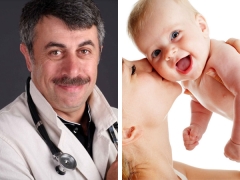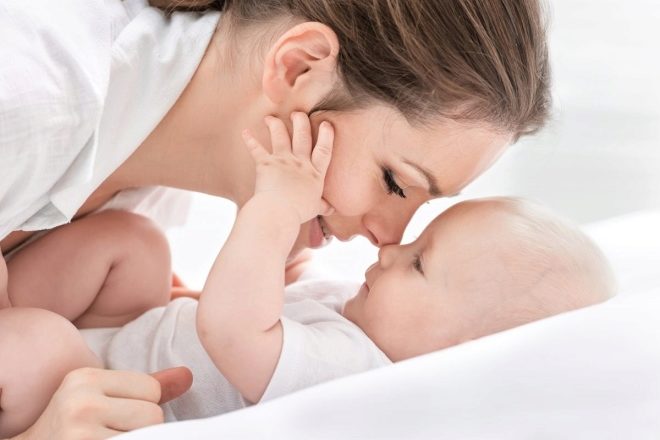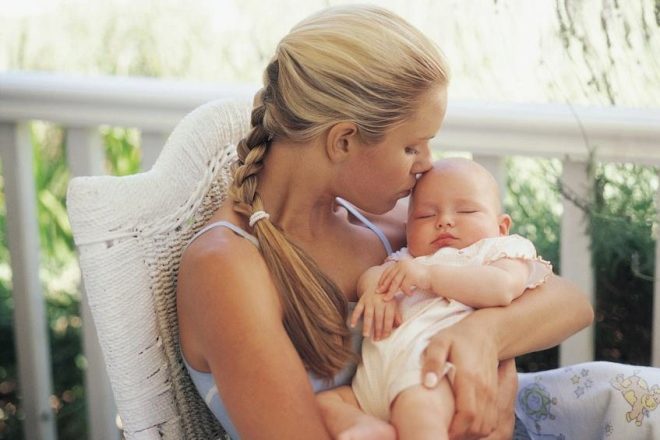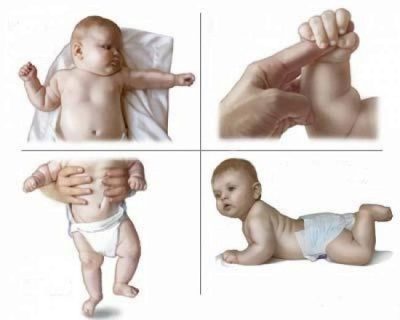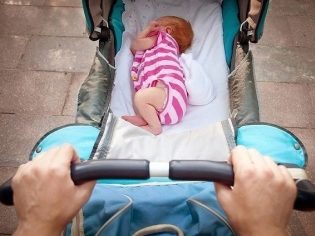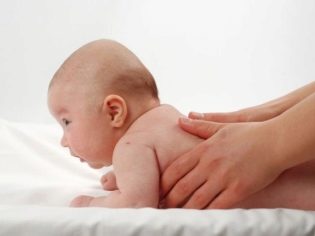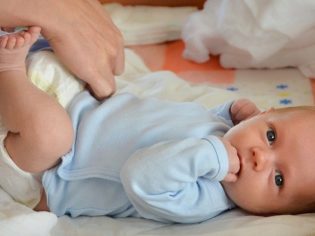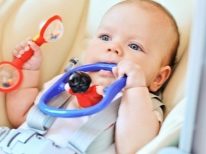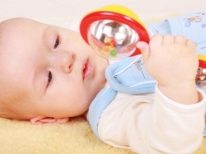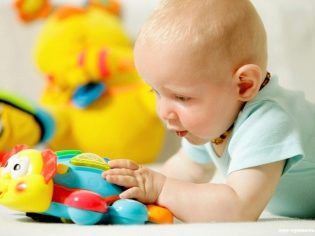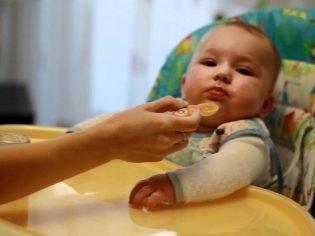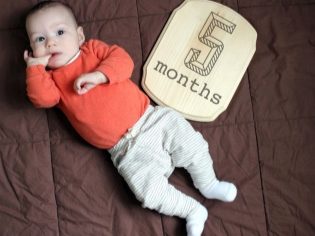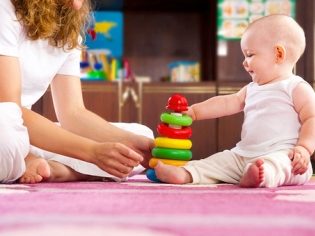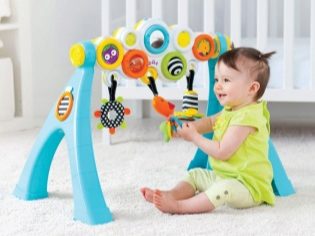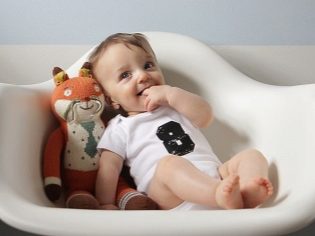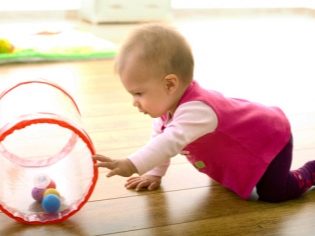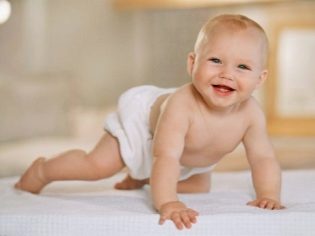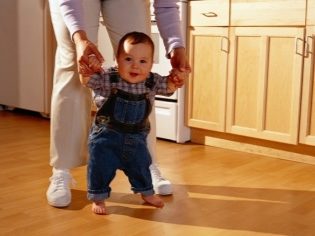Dr. Komarovsky on the development of newborns and infants for months
The kid was born and from the first days surprises and pleases his parents. Mom and Dad eagerly peer into the crumbs - what's new he can now, what changes have occurred in him. The babies of the first year of life are changing quite rapidly. Therefore, there is nothing surprising in the fact that parents are interested in whether a baby develops in a timely manner, whether it is lagging behind its peers, whether its development (physical and emotional) fits into generally accepted norms. About this written many books and articles. The authoritative children's doctor Yevgeny Komarovsky tells a lot and in detail about the development of babies by months.
Newborn
Your baby is considered a newborn from the moment it was born until it reached 28 weeks of age. Four calendar weeks - this is exactly the time nature took for the formation of basic skills. During this period, the small person's senses are improved, with the help of which he will study the world around him. He sees so far only blurry spots of different brightness, the newborn will learn to focus his eyesight later. The hearing at birth is somewhat reduced, but already for 3-4 days baby starts to hear the world is exactly the same as adults do. He clearly distinguishes tastes (bitter, sweet, sour), the sense of touch is quite developed, so tactile contact is a very important element of knowing the world in the first weeks of independent life.
Day regimen of the newborn in the first month plays a large role for further development. How parents organize food, bathing, walks and sleep, depends on how healthy and strong the peanut grows. The baby just seems tiny and helpless. His skills are determined by nature itself, and it may not be as little as parents think. A newborn up to 1 month demonstrates reflexes that are peculiar only to him, as they grow older, they disappear as unnecessary. Parents can quite easily evaluate basic reflexes:
Grasp reflex. Hold your index finger close to the palm of your baby, he will surely grab it very tightly.
Reflex hugs. Put the crumb on a hard surface (for example, on a changing table), sharply tap on the surface of the table with your palm. A loud sound and vibration will cause movements in the baby that are similar to the movements of an adult with hugs - first, the baby will bend back and spread his arms wide, and then he will return them to the position at the chest.
Crawling reflex. From the prone position, the baby will make reflex movements that are used when crawling.
Step reflex. Take the baby under the arms and hold it vertically. If you lightly rest his feet on a hard surface, he pushes them off, spins. If at the same time slightly tilting the body of the child forward, he will take several "steps" with his feet.
Height and weight
For the first month of life, an average child, whether boy or girl, adds an average of 450 to 700 grams in weight and 1.5–2 centimeters in height. These parameters are very individual, according to Komarovsky, and therefore you should not compare your child with others only according to these criteria.
Recommendations
In the first month, special attention should be paid by parents to the formation of reflexes of the crumbs, the establishment of a clear daily regimen.Newborn care should be based on the principles of creating optimal conditions for the development of its immunity (bathing in cool water according to Komarovsky's method, walking, air temperature not more than 20 degrees in the room, humidity in the room within 50-70%).
1 month
The neonatal period is over. The crumb of the muscle decreases somewhat, the movements with arms and legs become less constrained, but more chaotic. Umbilical wound healed. The baby is still sleeping a lot - from 17 to 20 hours a day. At this age, the average child should be able to briefly hold the head in the prone position. His eyesight is improving, the peanut can already fix his gaze on a stationary large and bright object for a few seconds.
The emotional sphere is developing - the baby already recognizes the mother, though not visually, but by scent, touch and voice. But he already knows how to rejoice at her, while bending back and throwing up her arms (hug reflex). The crumb makes the first attempts to imitate sounds.
Height and weight
Girls (born with a weight of more than 3 kilograms) weigh an average of 4150-4400 grams per month, their height is 53-55 cm. Boys weigh 4400-4900 grams, their height ranges from 54-56 cm.
Recommendations
At this age, it is useful not only swimming in cool water, but also swimming. Yevgeny Komarovsky advises to transfer the child to a large bath. If parents are afraid to let the baby swim with a little support, you can buy a special circle for swimming. It comfortably fixes the neck and gives the child the opportunity to swim, to make turns in the water.
2 months
Dramatic changes have taken place in the child's appearance: he no longer resembles an alien creature, his face has found cute features, on the whole, the child has become much calmer, his movements are no longer so sharp and chaotic. The baby sleeps about 19 hours a day. Sleep is getting stronger. The kid is able to focus his gaze not only on fixed objects, but also on mum moving around the apartment.
When laying out on the tummy, the crumb keeps the head for about 15-20 seconds. If you lay it on its side, it turns itself on its back. At 2 months, many babies begin to consciously smile full-mouth to people whom they know well (mom, dad). Peanut funny ghouls, singing vowels. He learned to determine where the sound comes from and turn the head in that direction.
Height and weight
A two-month baby grows on average about 800 grams in weight and about 2 centimeters in height.
Recommendations
Closely monitor the development of skills at this age. If the two-month-old baby doesn’t try to lift the head at all and hold it, doesn’t react to the sounds, doesn’t show a reaction in response to the tender words of the mother, this is a reason for examination by specialist doctors (pediatrician, neurologist, ENT).
For information on whether to drive the kid to swim in the pool, see the transfer of Dr. Komarovsky.
3 months
The three-month-old peanut is already a real handsome man, due to the growth of fatty subcutaneous tissue, his body becomes more plump, there are dimples on his cheeks (not at all). The kid has very likely learned to roll over from the back to the tummy and lean on his forearms, lying on his stomach, he rises with his whole body, leaning on the handles. The child is drawn to objects that interest him, and if they manage to be grabbed, he immediately pulls into his mouth.
He distinguishes between all the primary colors, he likes different to the touch toys and pieces of fabric, as tactile perception is improved.
Height and weight
The average weight gain per month is about 800 grams, in growth - 2.5-3 centimeters.
Recommendations
Developing games will already be perceived by the child as games, that is, the process of the game becomes interesting to it, and therefore it's time to experiment with rattles, rattles and squeakers.
Gymnastics for physical development should be daily and mandatory, you can add a massage to it, aimed at strengthening the muscles of the back, neck and abdomen.
4 months
Unconditioned reflexes fade away, some have already disappeared completely, for example, the Moro reflex, which is popularly called the embrace reflex. The muscles of the handles are no longer in good shape, but the legs can still remain in tension, and this should not frighten parents. The digestive system is developing rapidly, so that many children at this age lose such an unpleasant and painful physiological phenomenon as infant colic.
The kid is already in dire need of emotional communication, he is actively walking, deaf consonants are added to the vowel sounds, he willingly smiles knowingly, some even begin to laugh, the child listens with interest to the music.
The baby is sleeping about 15 hours a day, waking periods can already be about 2 hours, and this time must be used to the maximum - twice a day to massage the baby, at least twice a day to walk with him, to conduct educational activities.
Weight and height
In the fourth month of independent life, the baby should gain about 700 grams in weight, about 2.5 centimeters in height.
Recommendations
It is necessary to trim the baby’s nails more often to avoid injuries, since in four-month crumbs the nails and hair begin to grow at an unprecedented rate.
In addition, parents should more often encourage the individuality of the crumbs, according to Komarovsky, at this age he already perfectly distinguishes himself from the environment and begins to realize himself as a person.
5 months
Emotional communication comes first. The child very expressively babbles, gulit, sings. Laughter and smile are already 100% conscious. Some children (however, not all) by the end of the fifth month can sit with the support of the back. Almost all the kids at this age are learning a new, interesting form of leisure - while lying on their backs, they tighten their legs upwards and easily take the heel into their mouths.
The crumb recognizes faces perfectly, already divides people into acquaintances and strangers, looks at herself in the mirror with pleasure, and manifests strong conscious anxiety when her mother leaves the house for a while. Coordination of movements is almost perfect - the baby, without taking his eyes off the object, can reach out to him with his hand, grab it and immediately send it to his mouth. Now the kid can play for 5-15 minutes by himself.
Height and weight
Understand whether everything is in order with these indicators will help a simple way: the weight of the crumbs of birth should be multiplied by 2. The average weight in five months. The increase for the fifth month is about 700 grams. In growth the baby adds 3 centimeters.
Recommendations
At this age, Komarovsky does not recommend something to change the baby's diet.
The reasons for the introduction of the first complementary foods can be very good reasons, since there is a shortage of breast milk, a small weight gain (it should be stated by the pediatrician, and not a caring grandmother), frequent stomach problems and abundant regurgitation.
6 months
Muscles develop at a rapid pace, so many children in half a year can sit without support, some begin to make first attempts. crawl. The child in general becomes incredibly mobile, an eye and an eye are needed for it. Salivation increases, and many babies get their first teeth (usually the lower incisors).
Coordination of movements is improved, now the kid is not just reaching for an interesting toy and grabs it, but it can quite easily pick up the object that has fallen out of the hands. The karapuz advances in mental development by leaps and bounds, he already builds cause-and-effect relationships perfectly: if the rattle is shaken, it will boom, if you quit, it will fall, if you scream, mom will come; .
The child reacts to his own name, smiles in return, he listens attentively to the speech, and with familiar words he becomes noticeably animated, throws out his arms and legs.Different sounds of the baby trying to tie in syllables. While there is no special sense in them, he simply tries to produce new sound effects, and the process gives the child real pleasure. If the baby is fed with a spoon, the six-month-old baby is well aware that you need to open your mouth wide during feeding.
Height and weight
In the sixth month, the crumb on average is gaining more than 600 grams in weight and grows up by 2 centimeters.
Recommendations
If the child does not sit down in six months, parents do not need to force him to sit down by force. Komarovsky calls in this case to encourage crawling in every way. There are children who crawl learn before they sit, and there are no deviations in it.
That is worth considering when crawling baby, look in the program.
7 months
Baby changes every day. He no longer looks like a helpless creature, most of the crumbs at this age are sitting perfectly, many are crawling, some are trying to stand, holding on to the support. It is interesting that the right hemisphere of the brain develops at a faster rate, and therefore more often the child will use his left hand, but this does not mean that he is left-handed. The baby's vision is developed at a high level, he not only watches moving objects, but is also able to distinguish them at different distances.
The crumb actively learns the world, and he does it through objects - he shakes, turns them over, tastes, tastes, throws and moves. A seven-month-old baby eats well from a spoon, already masters a mug, he himself holds the bottle with a drink.
Weight and height
In the seventh month, the growth of the child increases by 2 centimeters, the weight of an average of 600 grams.
Recommendations
Special attention should be paid to the development of speech at this age. The kid is already able not only to add sounds into syllables, but also to use certain syllables in specific situations.
During the walk, during the game, it is desirable to clearly tell the child everything he sees, to pronounce the names by syllables. So he will be able to quickly call things with their names. Feed to enter - according to the schedule. A child of this age no longer needs feeding at night.
8 months
From a prone position, the baby can sit down and lie back. Turning at this age tots in general can in various directions. Some kids already know how to play “ladies”, and almost everyone has learned to take small objects with their fingers (fine motor skills develop). With a special delight, children at 8 months recognize themselves in the mirror and in the photos. They have already learned to remove socks from their feet.
Toddlers of this age begin to be afraid of loud noises, and therefore can cry if they include a vacuum cleaner or a blender. Baby understands the praise. He strives for socialization, reacting animatedly to other children, trying to establish contact with them.
Height and weight
Growth rates slow down somewhat. For the eighth month, the baby is gaining an average of 500 grams, and its growth is increased by 1.5 centimeters.
Recommendations
If the teeth of an eight-month baby do not yet exist, there is no need to panic, everything has its time. At this age in general, the gap in the development of different children increases. Some are already able to stand with support, others are only trying to sit down.
If the child is healthy, he is gaining weight well, Komarovsky advises not to compare his development with statistical norms, but to take into account his individuality.
The opinion of the doctor about whether to use a walker, you can learn from his transfer.
9 months
The child is already crawling confidently. And it does not really matter how exactly he does it - on all fours or on his bellies, both options are the norm. The kid knows how to sit, and some are quite well able to stand in the arena, holding on to the sides. In the game, the peanut is already expressing his preferences - he chooses a certain toy, and not the one that has turned up, tries to use two toys, knocking them together and looking for other uses for them.
You can train your baby names of parts of the body. He will be happy to show them with his finger.At this age, children love watching their elders, trying to copy their actions.
Height and weight
For a month, an average child adds about 500 grams and grows up to 1.5 centimeters.
Recommendations
The child has become very inquisitive and mobile, he can begin to explore pieces of furniture, drawers and dressers. This is the time when the risk of getting a variety of injuries - bruises, hematomas, burns, cuts increases. Parents should be more attentive, and also remove all potentially dangerous items from the child’s reach.
10-11 months
During this period, the baby can start walking. The first timid steps, of course, can happen later, and there is no deviation from the norm in this. A child perfectly understands appeals to himself, can fulfill simple requests of parents - give a ball, take a spoon. He perfectly feels and copies the mood and behavior of others. Physical development fades into the background, the first is mental and emotional.
Speech is especially active. The more the child is read, the more often they talk to him, the greater the chance that he will please his loved ones every day with some new word or his likeness.
Height and weight
For the tenth and eleventh months, children add an average of 400-450 grams. Growth increases by 1.5 centimeters per month.
Recommendations
The older the baby gets, the more lags and advances parents will find, referring to the development calendar.
The doctor urges to remain calm and not rush the child, if he has not yet begun to walk or speak in whole words. And even more so this is not a reason to start dragging him to the doctors.
1 year
This is an important period, which sums up a peculiar result of everything that the baby has learned before the age of 1 year. He has well developed all muscle groups, many children have up to 8 teeth by the year, although some have only 1-2. The kid can independently squat and get out of this position without the help of adults, he overcomes small heights - for example, he can climb on a chair or on a sofa. The average speech margin is about 15 simple words. Many yearlings are great at assembling and disassembling a pyramid or a tower of colored cubes.
A long-term memory is being improved - a crumb remembers what happened yesterday and even the day before yesterday. By the year a child can have a good job with cutlery and drink from a cup, as well as carry out simple instructions from parents (submit something, put something somewhere).
Height and weight
The weight of the child has tripled since birth, the growth over the last month has increased by 1.5 centimeters on average. From this age, the baby will start growing and gaining pounds much slower.
Recommendations
In the year of the baby waiting for a large medical planned examination. Be sure to share with the doctor all the concerns that parents have accumulated. Usually, the results and examinations of specialists can dispel all fears of moms and dads. Children who are a little behind in development after a year, as a rule, quickly “catch up” with their peers.
For details, see below in the transfer of Dr. Komarovsky.
